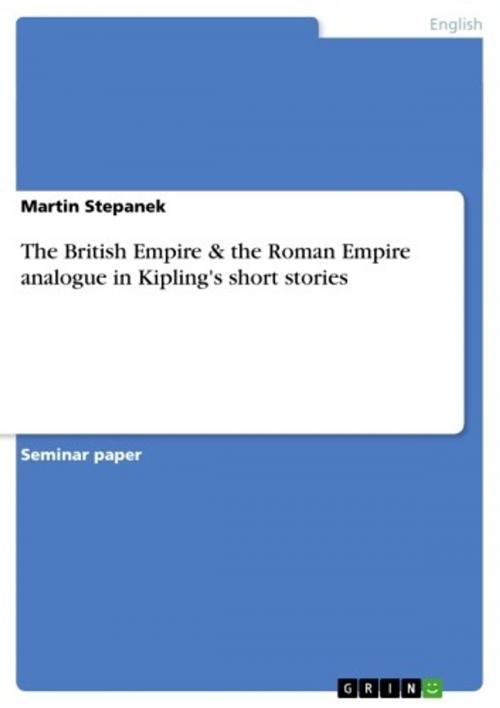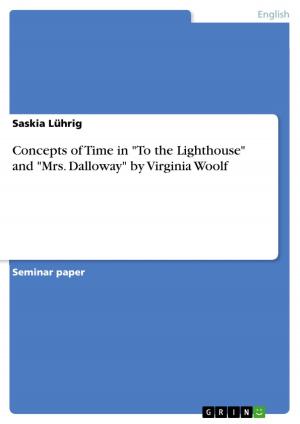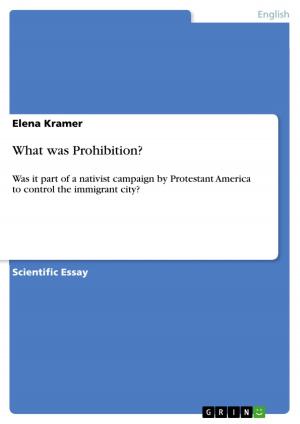The British Empire & the Roman Empire analogue in Kipling's short stories
Fiction & Literature, Literary Theory & Criticism, British| Author: | Martin Stepanek | ISBN: | 9783638179614 |
| Publisher: | GRIN Publishing | Publication: | March 29, 2003 |
| Imprint: | GRIN Publishing | Language: | English |
| Author: | Martin Stepanek |
| ISBN: | 9783638179614 |
| Publisher: | GRIN Publishing |
| Publication: | March 29, 2003 |
| Imprint: | GRIN Publishing |
| Language: | English |
Seminar paper from the year 2000 in the subject English Language and Literature Studies - Literature, grade: very good, University of Vienna (Anglistics/American Studies), 18 entries in the bibliography, language: English, abstract: Critics seem to differ widely in their opinion about the Puck-stories and what role they should play in regard of Kipling's total work. Hinchcliffe (1989: 157) states that Puck of Pook's Hill clearly is among the 'neglected books', and that its stories were neither liked by 'children, for whom they were ostensibly written', nor by adults, who seem to prefer 'the more obviously adult stories'. Other critics, on the other hand (Henn 1967: 41 and Birkenhead 1978: 247), believe the book to be one of his most popular collections, equally and unquestionably loved by children and grown-ups for their humour and their liveliness in narration. Indeed, when Puck of Pook's Hill was published for the first time, the audience's response seems to have been rather restrained. Readers and critics probably felt unsure of how these stories were to be taken and for which audience they were actually intended. From a present point of view and with regard to Kipling's work it seems clear that to treat the Puck-stories simply as a collection of fairytales for children, which for many years has been the case, does not seem appropriate. Already in Something of Myself Kipling himself declared wittily, if not dramatically that 'the tales had to be read by children, before people realised that they were meant for grown-ups' (190). This hint, given by the author himself, does certainly confirm our hunch that there is and that there must be more to the stories than what seems apparent at a superficial first reading. A closer look at the stories in Puck of Pook's Hill reveals that despite fairly straight-forward, accessible language and story plots which can easily be followed by the reader or the audience, Kipling actually created some of the most wonderfully complex and artistically rich stories, by 'working', as he himself called it, 'the material in three or four overlaid tints and textures, which might or might not reveal themselves according to the shifting light of sex, youth and experience' (Something of Myself: 190).
Seminar paper from the year 2000 in the subject English Language and Literature Studies - Literature, grade: very good, University of Vienna (Anglistics/American Studies), 18 entries in the bibliography, language: English, abstract: Critics seem to differ widely in their opinion about the Puck-stories and what role they should play in regard of Kipling's total work. Hinchcliffe (1989: 157) states that Puck of Pook's Hill clearly is among the 'neglected books', and that its stories were neither liked by 'children, for whom they were ostensibly written', nor by adults, who seem to prefer 'the more obviously adult stories'. Other critics, on the other hand (Henn 1967: 41 and Birkenhead 1978: 247), believe the book to be one of his most popular collections, equally and unquestionably loved by children and grown-ups for their humour and their liveliness in narration. Indeed, when Puck of Pook's Hill was published for the first time, the audience's response seems to have been rather restrained. Readers and critics probably felt unsure of how these stories were to be taken and for which audience they were actually intended. From a present point of view and with regard to Kipling's work it seems clear that to treat the Puck-stories simply as a collection of fairytales for children, which for many years has been the case, does not seem appropriate. Already in Something of Myself Kipling himself declared wittily, if not dramatically that 'the tales had to be read by children, before people realised that they were meant for grown-ups' (190). This hint, given by the author himself, does certainly confirm our hunch that there is and that there must be more to the stories than what seems apparent at a superficial first reading. A closer look at the stories in Puck of Pook's Hill reveals that despite fairly straight-forward, accessible language and story plots which can easily be followed by the reader or the audience, Kipling actually created some of the most wonderfully complex and artistically rich stories, by 'working', as he himself called it, 'the material in three or four overlaid tints and textures, which might or might not reveal themselves according to the shifting light of sex, youth and experience' (Something of Myself: 190).















